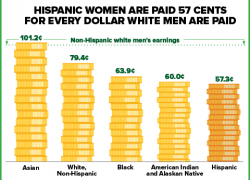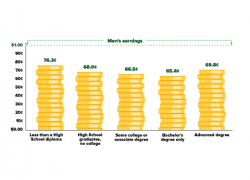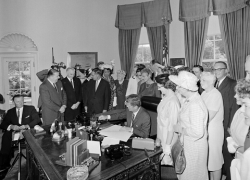
Aurora Bihler waited tables for years. Despite being more experienced than her male co-worker, she later learned that he was paid more doing the same job. That all changed when she joined Ironworkers Local 396 in St. Louis eight years ago. Not only was this a higher paying job, but she also worked alongside her male counterparts as an equal, and was able to buy a car and her own home. She credits being in a union for helping her achieve what is out of reach for too many working women – financial independence. To pay it forward, she is now focused on helping women and diverse candidates enter the union building trades so they can have the same opportunities through a program called the Missouri Works Initiative. Her Valentine’s Day wish is for more women to experience the transformative difference a union can make in their own lives.
Aurora’s story is not unique. The Bureau of Labor Statistics findings are clear. Unionized women make on average 23% more than women without a union. They are also far more likely to have paid leave and stronger protections against discrimination and sexual harassment in the workplace. So yesterday we not only observed Valentine’s Day, but also Union Women Equal Pay Day – when union women reach what men earned in 2021 – ahead of when non-union women catch up.
Union Women Equal Pay Day comes a full month earlier than Equal Pay Day for all women because of the significantly smaller pay gap between unionized women and men. Being represented by a union reduces women’s wage gap by nearly 40 percent compared to the pay gap experienced by non-union women. For Black and Latina women, the union advantage is even greater. This translates into hundreds of thousands of additional dollars in union women’s pockets over the course of their careers.
Greater pay equity exists for union workers because of the transparency and equality provided by a union contract. Collective bargaining agreements apply to all workers at a job, regardless of their race or gender. Importantly, workers with unions feel more secure speaking out about pay and other workplace issues, because they know they have the power of a union.
Some may wonder why Union Women Equal Pay Day isn’t Jan. 1? Why is there a pay gap at all?
The answer lies in the jobs women do – men still hold the highest-paying jobs in our economy in construction and manufacturing, so women’s pay, mostly in service occupations and industries, on average, is lower. This is a persistent problem that suppresses the wages of women and workers of color – and even more so for workers without the benefit of a union. Creating opportunities for women like Aurora in these higher-paying jobs is a top priority for both the Biden-Harris administration and the AFL-CIO.
In order to ensure equal pay across the board, the Biden-Harris administration established the White House Task Force on Worker Organizing and Empowerment to find ways that federal government agencies can use their authority to support the formation of unions. The task force just released its first report, containing nearly 70 recommendations. At the U.S. Department of Labor’s Women’s Bureau, we are finding ways to get information about organizing and bargaining rights into the hands of more workers, so more working women will know about opportunities they have to form a union. And we are going to work with other agencies on a Unions and Collective Bargaining Resource Center, so more workers will have information about the many ways having a union can improve their lives.
Union approval is the highest it has been in nearly 50 years, with 60 million non-union workers saying they would vote for a union if they could. Now is the time to act. Encourage the women in your lives to get union cards.
Wendy Chun-Hoon is the director of the Women’s Bureau at the U.S. Department of Labor. Liz Shuler is the president of the AFL-CIO, a federation of 57 national and international unions representing 12.5 million workers.

 U.S. Department of Labor Blog
U.S. Department of Labor Blog







